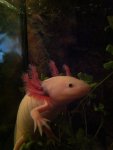I have 2 axolotls they are about 1 year old. I just noticed that one of them has much less feathery gills than the other one and I'm sure they used to be the same!
I've also noticed lots of little white worms on the glass and was wondering if they could have eaten his gills??
I have a sand substrate and feed them on pellets, occasionally little bits of fish or meat. He has a healthy appetite and I can see no fungus or any other signs of illness, I hope that i'm just being paranoid!
Any help would be greatly appreciated!
on the photos the one with white eyes has the shorter gills, they used to look like the one with black eyes.
I've also noticed lots of little white worms on the glass and was wondering if they could have eaten his gills??
I have a sand substrate and feed them on pellets, occasionally little bits of fish or meat. He has a healthy appetite and I can see no fungus or any other signs of illness, I hope that i'm just being paranoid!
Any help would be greatly appreciated!
on the photos the one with white eyes has the shorter gills, they used to look like the one with black eyes.


